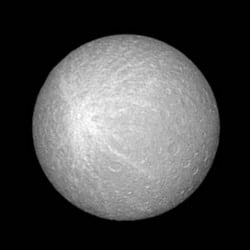Saturn's moon Rhea. Image credit: NASA/JPL/SSI.
Click to enlarge
This view of Saturn's moon Rhea shows the tremendous bright splat that coats much of the moon's leading hemisphere. The bright feature may be impact-related and is visible in other Cassini images of Rhea (see
Diversity of Impacts
). Rhea is 1,528 kilometers (949 miles) across.
North on Rhea is up in this view.
The image was taken in visible green light with the Cassini spacecraft narrow-angle camera on June 25, 2005, at a distance of approximately 1.1 million kilometers (700,000 miles) from Rhea and at a Sun-Rhea-spacecraft, or phase, angle of less than one degree. Resolution in the original image was 7 kilometers (4 miles) per pixel. The image has been contrast-enhanced and magnified by a factor of two to aid visibility.
The Cassini-Huygens mission is a cooperative project of NASA, the European Space Agency and the Italian Space Agency. The Jet Propulsion Laboratory, a division of the California Institute of Technology in Pasadena, manages the mission for NASA's Science Mission Directorate, Washington, D.C. The Cassini orbiter and its two onboard cameras were designed, developed and assembled at JPL. The imaging operations center is based at the Space Science Institute in Boulder, Colo.
For more information about the Cassini-Huygens mission visit
http://saturn.jpl.nasa.gov
. The Cassini imaging team homepage is at
http://ciclops.org
.
NASA/JPL/SSI News Release
 Universe Today
Universe Today
